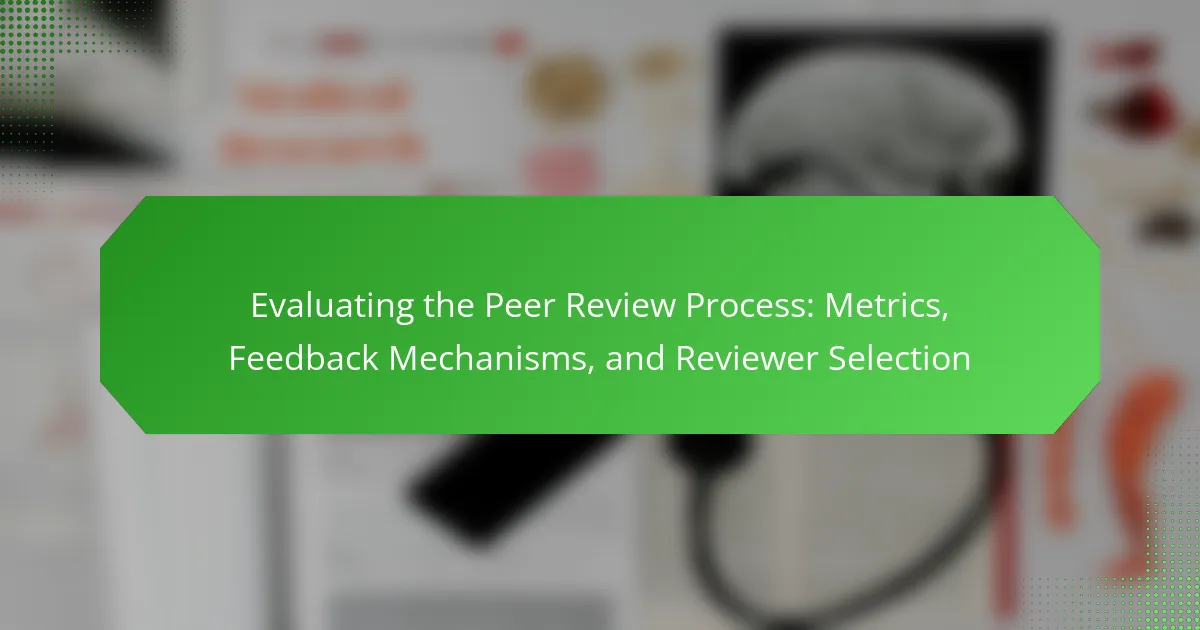The peer review process is a systematic method for evaluating the quality and validity of academic work, involving expert reviewers who assess manuscripts prior to publication. Key metrics used to evaluate this process include time to review, reviewer quality, and acceptance rates, which help journals measure the efficiency and effectiveness of their peer review systems. Feedback mechanisms such as reviewer comments, editor decisions, and author responses play a crucial role in enhancing manuscript quality through an iterative collaboration. Additionally, the selection of qualified reviewers is critical for maintaining objectivity and integrity, impacting the overall quality of peer reviews and the publication process. This article provides a comprehensive overview of these aspects, highlighting the importance of metrics, feedback, and reviewer selection in the peer review process.
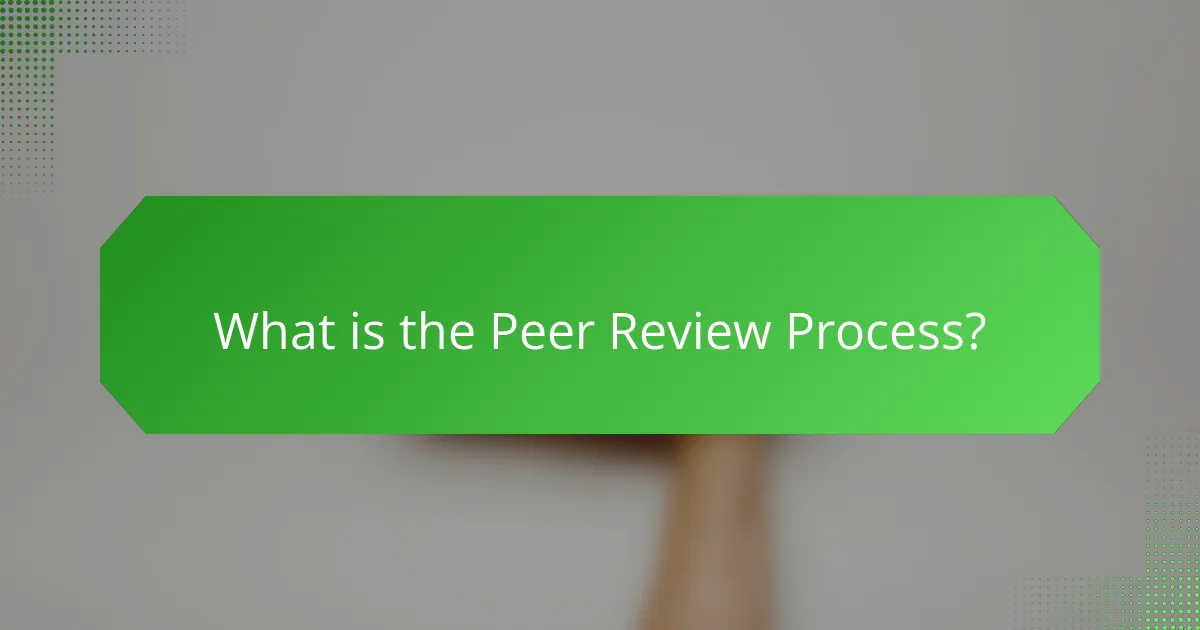
What is the Peer Review Process?
The peer review process is a method used to evaluate the quality and validity of academic work. It typically involves experts in the field reviewing a manuscript before publication. Reviewers assess the research for originality, significance, and methodological rigor. They provide feedback and recommendations to the authors and the editorial board. This process helps ensure that published research meets established standards. Peer review is a critical step in maintaining the integrity of academic literature. Studies show that peer-reviewed articles are more likely to be credible and influential.
How does the Peer Review Process function in academic publishing?
The peer review process in academic publishing involves several key steps. First, authors submit their manuscripts to a journal. Next, the journal editor evaluates the submission for relevance and quality. If deemed suitable, the editor sends the manuscript to experts in the field for review. These reviewers assess the work’s validity, originality, and significance. Reviewers provide feedback and recommend acceptance, revision, or rejection. Authors then receive the reviewers’ comments and make necessary changes. Finally, the editor makes the final decision based on reviewers’ feedback. This process ensures the integrity and quality of published research.
What are the key stages of the Peer Review Process?
The key stages of the Peer Review Process include submission, initial assessment, peer review, editorial decision, and publication. During submission, authors submit their manuscript to a journal. The initial assessment involves the editor evaluating the manuscript for suitability. In the peer review stage, independent experts review the manuscript for quality and validity. The editorial decision stage follows, where the editor decides to accept, revise, or reject the manuscript based on reviewer feedback. Finally, if accepted, the manuscript moves to publication. Each stage is crucial for ensuring academic integrity and quality in scholarly publishing.
Who are the main participants in the Peer Review Process?
The main participants in the peer review process are authors, reviewers, and editors. Authors submit their manuscripts for evaluation. Reviewers assess the quality and validity of the submitted work. Editors manage the review process and make publication decisions. This structure ensures a thorough evaluation of research before publication. Each participant plays a crucial role in maintaining the integrity of academic publishing.
Why is the Peer Review Process essential for research quality?
The Peer Review Process is essential for research quality because it ensures that studies are evaluated by experts before publication. This process helps identify flaws in methodology, data interpretation, and conclusions. Peer review serves as a quality control mechanism that enhances the credibility of published research. Studies that undergo peer review are more likely to be reliable and valid. According to a study published in the journal “Nature,” peer-reviewed articles are cited more frequently than non-peer-reviewed ones, indicating their higher impact. The process fosters a rigorous assessment of research, promoting scientific integrity and trust in published findings.
What role does peer review play in maintaining academic integrity?
Peer review plays a crucial role in maintaining academic integrity. It ensures that research is evaluated by experts before publication. This process helps to identify and correct errors or biases in the work. Peer reviewers assess the validity and reliability of the research methods used. They also evaluate the significance and originality of the findings. By holding researchers accountable, peer review discourages misconduct such as plagiarism and data fabrication. Studies show that peer-reviewed articles are more likely to be credible and trustworthy. For instance, a study published in the journal “Nature” found that peer review significantly improves the quality of published research. Thus, peer review serves as a gatekeeping mechanism that upholds the standards of academic integrity.
How does peer review impact the credibility of published research?
Peer review enhances the credibility of published research by ensuring rigorous evaluation by experts. This process involves independent reviewers assessing the quality, validity, and originality of the research. Studies indicate that peer-reviewed articles are more likely to be cited than non-peer-reviewed ones. A 2018 analysis found that peer-reviewed research received 50% more citations on average. Furthermore, peer review helps identify errors and biases, improving the overall reliability of findings. As a result, the peer review process serves as a quality control mechanism in academic publishing. This validation fosters trust among researchers, practitioners, and the public in the published work.
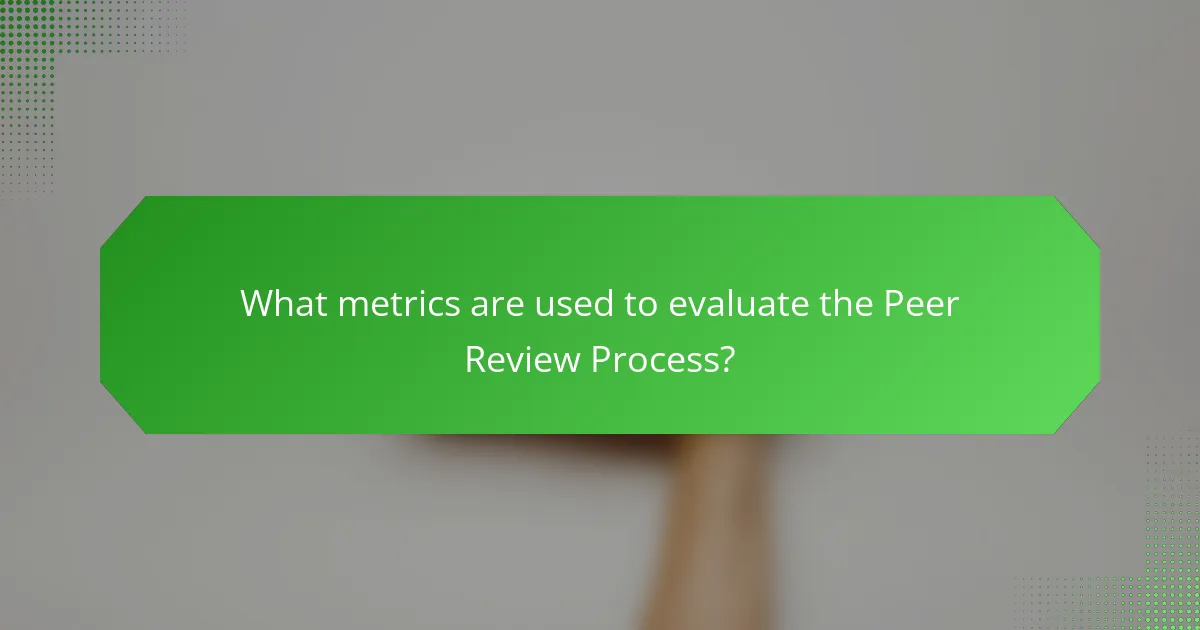
What metrics are used to evaluate the Peer Review Process?
Metrics used to evaluate the Peer Review Process include time to review, reviewer quality, and acceptance rates. Time to review measures how long it takes for a manuscript to undergo the review process. Reviewer quality is assessed through their expertise, feedback quality, and adherence to deadlines. Acceptance rates indicate the proportion of manuscripts that are accepted for publication. Other metrics may include the number of revisions requested and the level of agreement among reviewers. These metrics help journals assess the efficiency and effectiveness of their peer review processes.
Which quantitative metrics are commonly applied in peer review evaluation?
Common quantitative metrics applied in peer review evaluation include acceptance rates, reviewer scores, and citation counts. Acceptance rates measure the percentage of submitted manuscripts that are accepted for publication. Reviewer scores are numerical ratings given by reviewers based on the quality of the manuscript. Citation counts track how often published articles are referenced in other works, indicating their impact. These metrics help assess the efficiency and effectiveness of the peer review process. They provide tangible data that can guide improvements in editorial practices.
How do acceptance rates influence the perception of a journal’s quality?
Acceptance rates significantly influence the perception of a journal’s quality. A lower acceptance rate often suggests a more selective and rigorous peer review process. This selectivity can enhance the journal’s reputation among academics. Conversely, a higher acceptance rate may lead to perceptions of lower quality or less stringent review standards. Studies indicate that journals with lower acceptance rates are often ranked higher in academic metrics. For instance, the Journal Citation Reports often correlate lower acceptance rates with higher impact factors. Therefore, acceptance rates serve as a key indicator of perceived quality in academic publishing.
What is the significance of review turnaround time in peer review metrics?
Review turnaround time is significant in peer review metrics as it reflects the efficiency of the review process. A shorter turnaround time often indicates a more responsive and streamlined peer review system. This efficiency can enhance author satisfaction and improve the timeliness of research dissemination. Studies show that quicker reviews can lead to higher citation rates, as timely publication allows research to enter the academic conversation sooner. Additionally, review turnaround time can influence the reputation of journals, as faster reviews are often perceived positively by authors and the academic community. Overall, it serves as a key performance indicator for evaluating the effectiveness of the peer review process.
What qualitative metrics can be considered in peer review evaluation?
Qualitative metrics in peer review evaluation include reviewer expertise, the clarity of feedback, and the relevance of comments. Reviewer expertise assesses the knowledge and qualifications of the reviewer in the subject area. Clarity of feedback evaluates how understandable and actionable the reviewer’s comments are. Relevance of comments measures how well the feedback aligns with the manuscript’s content and objectives. These metrics help ensure the peer review process is effective and constructive. Research shows that high-quality peer reviews correlate with positive publication outcomes and enhance the overall quality of scientific literature.
How do reviewer comments contribute to the overall evaluation of submissions?
Reviewer comments significantly contribute to the overall evaluation of submissions. They provide detailed insights into the strengths and weaknesses of the work. Reviewers assess the originality, methodology, and relevance of the submission. Their feedback helps editors make informed decisions about acceptance or rejection. Comments also highlight areas for improvement, guiding authors in revisions. The quality of reviewer comments can influence the perceived credibility of the submission. Studies show that thorough reviews correlate with higher publication quality. Thus, reviewer comments are essential in shaping the final outcome of the submission process.
What is the importance of reviewer expertise in the evaluation process?
Reviewer expertise is crucial in the evaluation process as it ensures the quality and credibility of assessments. Expert reviewers possess in-depth knowledge of the subject matter. This expertise allows them to identify strengths and weaknesses in submissions effectively. Their background helps in providing constructive feedback that authors can use for improvement. Studies show that expert reviewers contribute to higher-quality publications. For instance, a review published in the Journal of Scholarly Publishing highlights that expert reviewers are more likely to catch methodological flaws. This ultimately enhances the integrity of the peer review process.
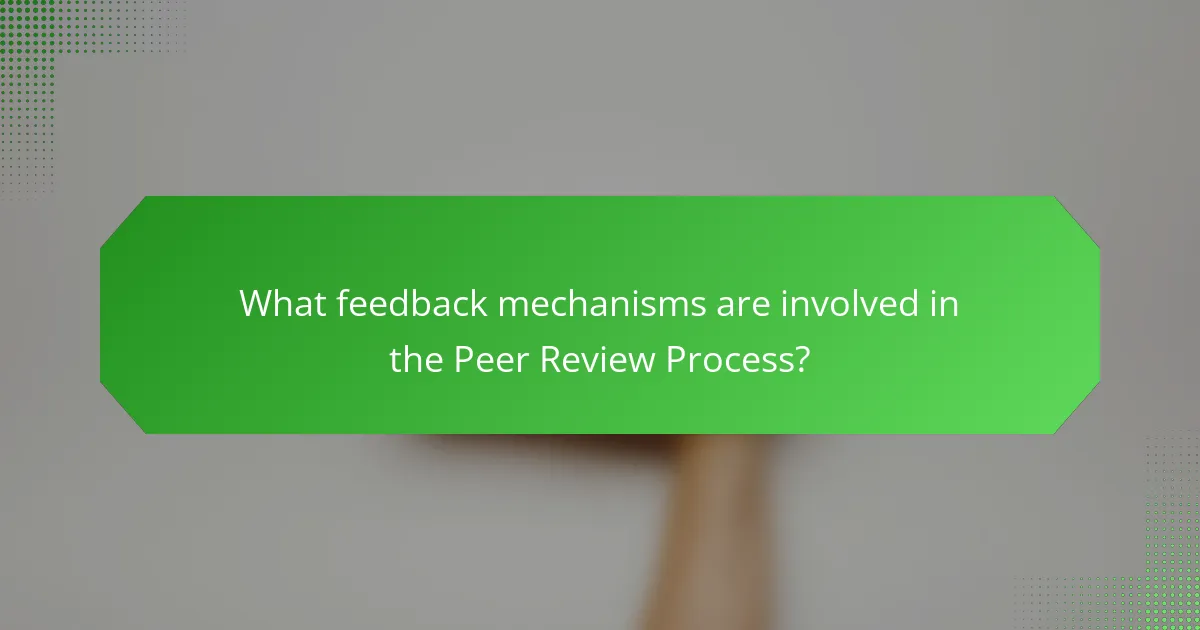
What feedback mechanisms are involved in the Peer Review Process?
The feedback mechanisms involved in the Peer Review Process include reviewer comments, editor decisions, and author responses. Reviewer comments provide critical assessments of the manuscript’s quality and validity. Editors use these comments to make informed decisions about publication. Author responses address the reviewers’ feedback and indicate revisions made. This iterative process enhances the manuscript’s quality. Additionally, feedback may include suggestions for improvement and requests for additional experiments or data. These mechanisms ensure that the final published work meets academic standards. Overall, the feedback process fosters collaboration between authors and reviewers, improving research integrity.
How is feedback provided to authors during the peer review process?
Feedback is provided to authors during the peer review process through detailed reviewer comments. Reviewers evaluate the manuscript and offer suggestions for improvement. These comments typically address the study’s methodology, results, and overall contribution to the field. Authors receive this feedback in a structured format, often alongside a decision letter from the journal. The decision letter may indicate whether the manuscript is accepted, requires revisions, or is rejected. Reviewers may also highlight strengths and weaknesses of the work. This feedback is crucial for authors to enhance the quality of their research before publication.
What types of feedback are most beneficial for authors?
Constructive feedback is most beneficial for authors. This type of feedback highlights strengths and weaknesses in a manuscript. It provides specific suggestions for improvement. Peer reviews that focus on clarity, coherence, and structure are particularly valuable. Feedback that addresses content relevance and originality helps authors refine their arguments. Additionally, feedback from diverse reviewers offers varied perspectives. Studies indicate that detailed critiques improve manuscript quality significantly. Authors benefit from actionable insights that enhance their writing and research.
How can authors effectively respond to reviewer comments?
Authors can effectively respond to reviewer comments by carefully addressing each point raised. They should categorize comments into major and minor issues. For major issues, authors must provide detailed explanations or justifications for their original choices. For minor comments, authors should make necessary adjustments and acknowledge the reviewer’s input.
Authors should maintain a professional tone throughout their responses. They should express gratitude for the reviewer’s feedback, regardless of their agreement with it. Clear and concise language enhances understanding.
Incorporating evidence from literature or data can strengthen the author’s arguments. Additionally, authors should ensure that all responses are well-organized and easy to follow. This methodical approach demonstrates respect for the review process and improves the manuscript’s quality.
What systems are in place for reviewers to provide feedback?
Reviewers can provide feedback through structured forms and online platforms. These systems allow for comments on the manuscript’s quality, clarity, and originality. Many journals utilize specific criteria for reviewers to address. Feedback is often submitted electronically, ensuring efficient communication. Some systems allow for anonymous feedback, protecting reviewer identities. Others may encourage open dialogue between reviewers and authors. Regular surveys may also be conducted to gather reviewer insights. These mechanisms help improve the peer review process and enhance future submissions.
How do structured review forms enhance the feedback process?
Structured review forms enhance the feedback process by providing a standardized framework for evaluations. This structure ensures consistency in feedback across different reviewers. It allows for clear criteria to be established, making it easier to assess specific aspects of the work. Reviewers can focus on relevant areas without ambiguity. Additionally, structured forms facilitate more objective assessments, reducing personal biases. Research indicates that structured feedback leads to improved clarity and actionable insights. Studies show that using standardized forms increases the quality of feedback received.
What role do editorial decisions play in the feedback loop?
Editorial decisions are crucial in the feedback loop of the peer review process. They determine which submissions proceed to review and how feedback is communicated to authors. Editors assess the relevance and quality of submissions based on established criteria. This assessment influences the overall integrity of the publication. Effective editorial decisions can enhance the quality of feedback provided to authors. They also shape the direction of future research by prioritizing certain topics. Studies show that strong editorial leadership correlates with improved review outcomes. Thus, editorial decisions directly impact the efficacy of feedback mechanisms in the peer review process.
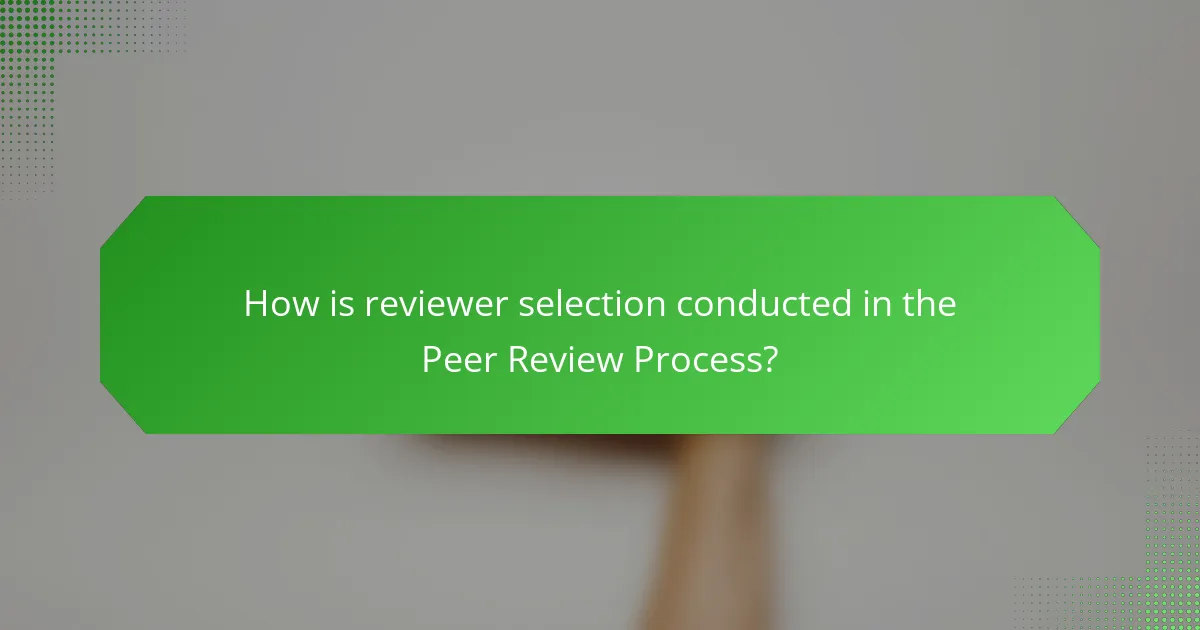
How is reviewer selection conducted in the Peer Review Process?
Reviewer selection in the peer review process involves identifying qualified experts in the relevant field. Editors typically conduct this selection based on the reviewers’ expertise, publication history, and previous review performance. The goal is to ensure that selected reviewers have the knowledge necessary to evaluate the manuscript effectively. Additionally, the editorial team may consider the potential conflicts of interest that reviewers might have. This process aims to maintain objectivity and integrity in the review. Research indicates that effective reviewer selection directly impacts the quality of peer reviews and, consequently, the overall publication process.
What criteria are used for selecting peer reviewers?
Criteria for selecting peer reviewers include expertise in the subject matter, publication record, and objectivity. Reviewers should possess relevant knowledge to evaluate the work effectively. A strong publication record indicates familiarity with the peer review process. Objectivity ensures unbiased evaluation of the manuscript. Additionally, availability and willingness to review are important factors. Institutions often consider the reviewer’s previous performance and feedback from authors. These criteria help maintain the integrity and quality of the peer review process.
How does a reviewer’s expertise align with the submitted manuscript?
A reviewer’s expertise aligns with the submitted manuscript through their specialized knowledge and experience in the relevant field. Reviewers are typically selected based on their academic qualifications and prior research contributions. Their familiarity with the specific subject matter allows them to assess the manuscript’s methodology, results, and implications effectively. For instance, a manuscript on cancer biology would benefit from a reviewer with a strong background in oncology research. This alignment ensures that the review process is thorough and constructive. Studies show that manuscripts reviewed by experts in the field receive more relevant feedback, enhancing the overall quality of the publication process.
What is the impact of reviewer conflicts of interest on the selection process?
Reviewer conflicts of interest can significantly skew the selection process. They may lead to biased evaluations of submissions. This bias can result in the unfair rejection or acceptance of manuscripts. Conflicted reviewers may favor work from their affiliations or those they know personally. Research indicates that such conflicts can undermine the integrity of the peer review system. A study published in the journal “Nature” highlighted that conflicts of interest can compromise the objectivity expected from reviewers. Therefore, managing these conflicts is crucial for maintaining a fair selection process.
What are the challenges in reviewer selection?
Reviewer selection faces several challenges. One major challenge is identifying qualified reviewers with the right expertise. This requires a deep understanding of the subject matter. Another challenge is ensuring impartiality and avoiding conflicts of interest. Reviewers may have biases that affect their evaluations. Additionally, finding available reviewers who can meet deadlines is often difficult. Many qualified experts have limited time due to their own commitments. There is also the challenge of maintaining diversity among reviewers. A lack of diversity can lead to narrow perspectives in the review process. Finally, the increasing volume of submissions can overwhelm the available pool of reviewers. This can result in delays and reduced quality in the review process.
How can biases affect the reviewer selection process?
Biases can significantly influence the reviewer selection process by skewing the impartiality required for fair evaluations. Selection may favor certain demographics, backgrounds, or affiliations, leading to a lack of diversity. This can result in a homogenous perspective that overlooks innovative ideas. Biases can also manifest in the form of favoritism towards known authors or institutions. Such favoritism compromises the integrity of the review process. Research indicates that biases can lead to systematic disparities in acceptance rates for different groups. A study by Budden et al. (2008) found that gender bias affected publication rates in scientific journals. Hence, biases not only affect reviewer selection but also the overall quality and fairness of the peer review process.
What strategies can be employed to improve reviewer diversity?
To improve reviewer diversity, organizations can implement targeted outreach strategies. These strategies include actively recruiting reviewers from underrepresented groups. Establishing partnerships with diverse academic institutions can broaden the reviewer pool. Additionally, offering training programs can prepare diverse candidates for the review process. Incentivizing diverse reviewers through recognition or compensation can also encourage participation. Finally, tracking and reporting diversity metrics can help organizations assess progress over time. Research shows that diverse perspectives enhance the quality of peer review, leading to more comprehensive evaluations.
What best practices can enhance the Peer Review Process?
Best practices to enhance the Peer Review Process include establishing clear guidelines for reviewers. These guidelines should outline expectations and criteria for evaluation. Training reviewers on these guidelines can improve consistency and quality of feedback. Implementing a double-blind review process can reduce bias. This approach protects the identities of both authors and reviewers. Regularly collecting feedback from reviewers can identify areas for improvement. Utilizing metrics to assess the review process can help measure its effectiveness. Encouraging diverse reviewer selection can enhance the breadth of perspectives. These practices collectively strengthen the integrity and reliability of the peer review process.
How can journals implement effective reviewer training programs?
Journals can implement effective reviewer training programs by developing structured training modules. These modules should cover essential topics such as the peer review process, ethical considerations, and evaluation criteria. Training can include workshops, online courses, and mentorship from experienced reviewers. Journals should provide clear guidelines and resources for reviewers to reference during evaluations. Regular feedback on reviewer performance can enhance their skills over time. According to a study published in “Research Integrity and Peer Review,” structured training significantly improves the quality of reviews. This evidence supports the effectiveness of comprehensive training programs in enhancing reviewer competence.
What tools can facilitate better communication between authors and reviewers?
Collaborative platforms can facilitate better communication between authors and reviewers. Tools like Google Docs allow real-time editing and commenting. These features enable authors to address reviewer feedback directly. Platforms such as Manuscript Central and Editorial Manager streamline submission processes. They offer structured feedback forms for clarity. Communication tools like Slack or Microsoft Teams can enhance discussions. They provide instant messaging and file-sharing capabilities. Email management tools can help organize correspondence efficiently. These tools contribute to a more transparent and effective review process.
The main entity of the article is the Peer Review Process, a critical method for evaluating the quality and validity of academic research. The article provides a comprehensive overview of the peer review process, detailing its function in academic publishing, key stages, and the roles of authors, reviewers, and editors. It explores the importance of peer review for maintaining research quality and academic integrity, as well as the metrics used to evaluate its effectiveness. Additionally, the article addresses challenges in reviewer selection, the impact of biases, and best practices for enhancing the peer review process, including effective communication and training for reviewers.
